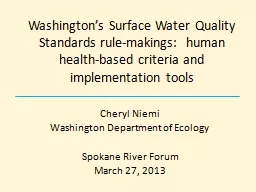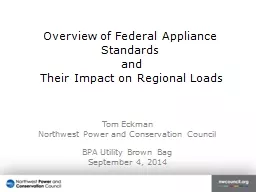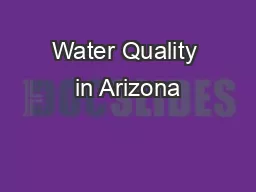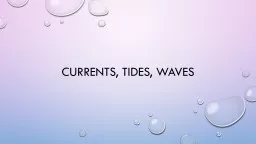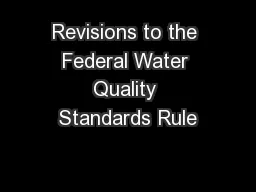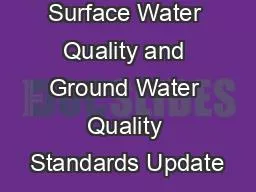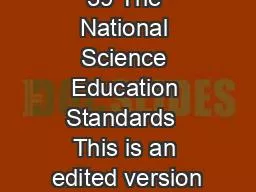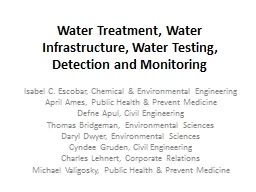PPT-Washington’s Surface Water Quality Standards rule-makings
Author : faustina-dinatale | Published Date : 2016-05-27
Cheryl Niemi Washington Department of Ecology Spokane River Forum March 27 2013 Two concurrent Surface Water Quality Standards WQS rule revisions Human healthbased
Presentation Embed Code
Download Presentation
Download Presentation The PPT/PDF document "Washington’s Surface Water Quality Sta..." is the property of its rightful owner. Permission is granted to download and print the materials on this website for personal, non-commercial use only, and to display it on your personal computer provided you do not modify the materials and that you retain all copyright notices contained in the materials. By downloading content from our website, you accept the terms of this agreement.
Washington’s Surface Water Quality Standards rule-makings: Transcript
Cheryl Niemi Washington Department of Ecology Spokane River Forum March 27 2013 Two concurrent Surface Water Quality Standards WQS rule revisions Human healthbased criteria HHC adoption Revised implementation tools focused on variances compliance schedules and likely intake credits. The World Water Development Report 1 Water for People Water for Life The World Water Development Report 2 Water A Shared Responsibility The World Water Development Report 3 Water in a Changing World Progress on Drinking Water and Sanitation Special and. Their Impact on Regional . Loads. . T. om Eckman. Northwest Power and Conservation Council. BPA Utility Brown Bag. S. eptember 4, . 2014. Savings from Many Mechanisms. Today’s Presentation. English Literature I. History/ The Makings of Modern Day English. About 449 AD, several large Germanic tribes, the Angles (from Denmark), Saxons (from Germany), and Jutes (from Jutland or Rhineland), traveled to the islands known as . Team 6. . Bingquan. Zhao, . Kaiyuan. Zhang, . Feng. Yang. , Hannah . Six. ,. Chenyang. Wang, . Zelin. Shao. 1. Water supplies for Arizona. Pollution Hazards. Government Standards. Current Technologies for water pollution control. Thesis. With the fall of Rome many Europeans found themselves with a common, sociocultural and patriarchal void in their lives. Eventually, with the long and often violent Christianization of Europe, that void was filled. However, this constant squabbling led to chaos on a large scale, causing medieval life to become incredibly dangerous for the common man. In order to cope with these dangers the lower classes gave up freedom to receive protection from the higher classes causing a rigid, hierarchical system to arise to keep balance and order. . Created by Winds. Coriolis Effect- The shifting of ocean currents and surface winds from their expected paths caused by the rotation of the earth. Gulf Steam – ocean current in the northern Atlantic ocean, brings warm water from Africa to the Americas. Jill Csekitz, Technical specialist. Texas Commission on Environmental Quality. Overview. History . Need for revision. Timeline. Major Revisions . Changes to Texas Surface Water Quality Standards anticipated?. EASTERN WASHINGTON UNIVERSITY. THE EVERGREEN STATE COLLEGE. UNIVERSITY OF WASHINGTON. WASHINGTON STATE UNIVERSITY. WESTERN WASHINGTON UNIVERSITY. October 2016. Paul Francis. Executive Director. About COP. EASTERN WASHINGTON UNIVERSITY. THE EVERGREEN STATE COLLEGE. UNIVERSITY OF WASHINGTON. WASHINGTON STATE UNIVERSITY. WESTERN WASHINGTON UNIVERSITY. October 2016. Paul Francis. Executive Director. About COP. November 16, 2018. 17. TH. Annual Regulatory Update Conference . Kimberly Cenno, Bureau Chief & Rachel White, . Env. specialist. Bureau of Environmental Analysis, Restoration and Standards (BEARS). Use our guide to find all of the supported exchanges and bitcoin ATMs within Washington quickly and efficiently. Download it now. Visit: https://www.smartbitcoininvestments.com/buy-bitcoin-in-washington/ 40 explanations for the seasons will be even more difficult to achieve Guide to the content Standard Fundamental concepts and principles that underlie this standard include Structure of the Eart Isabel C. Escobar, Chemical & Environmental Engineering. April Ames, Public Health & Prevent Medicine. Defne. . Apul. , Civil Engineering. Thomas Bridgeman, Environmental Sciences. Daryl Dwyer, Environmental Sciences. Adeetya's Kitchen & Furniture in Pune offers a selection of top-quality kitchen trolleys to maximize storage space and improve the functionality of any kitchen. https://adeetyas.com/high-quality-kitchen-trolleys-in-pune.php
Download Document
Here is the link to download the presentation.
"Washington’s Surface Water Quality Standards rule-makings"The content belongs to its owner. You may download and print it for personal use, without modification, and keep all copyright notices. By downloading, you agree to these terms.
Related Documents

